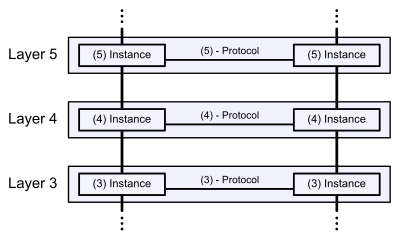原 IT理论
|-摘 OSI model-维基百科
OSI modelJump to navigationJump to searchOSI modelbylayer7.Application layer[show]Presentation layer[show]Session layer[show]Transport layer[show]Networ...
OSI model
Jump to navigationJump to searchOSI modelbylayer7.Application layer[show]
Presentation layer[show]
Session layer[show]
Transport layer[show]
Network layer[show]
Data link layer[show]
Physical layer[show]
TheOpen Systems Interconnection model(OSI model) is aconceptual modelthat characterizes and standardizes the communication functions of atelecommunicationor computing system without regard to its underlying internal structure and technology. Its goal is the interoperability of diverse communication systems with standardcommunication protocols. The model partitions a communication system intoabstraction layers. The original version of the model had seven layers.
开放系统互连模型(OSI模型)是一种概念模型,其描述和标准化了电信或计算系统的通信功能,而无需考虑其内部结构和技术。它的目标是使各种通信系统与标准通信协议实现互操作性。该模型将通信系统划分为抽象层。该模型的原始版本有七个层。
A layer serves the layer above it and is served by the layer below it. For example, a layer that provides error-free communications across a network provides the path needed by applications above it, while it calls the next lower layer to send and receive packets that constitute the contents of that path. Two instances at the same layer are visualized as connected by ahorizontalconnection in that layer.
开放系统互连模型(OSI模型)是一种概念模型,其描述和标准化了电信或计算系统的通信功能,而无需考虑其内部结构和技术。它的目标是使各种通信系统与标准通信协议实现互操作性。该模型将通信系统划分为抽象层。该模型的原始版本有七个层。一层服务于其上方的层,而服务于其下方的层。例如,在网络上提供无错误通信的层提供了其上层应用程序所需的路径,同时它调用了下一个较低的层来发送和接收构成该路径内容的数据包。将同一层的两个实例可视化为通过该层中的水平连接进行连接。
The model is a product of the Open Systems Interconnection project at theInternational Organization for Standardization(ISO).
Communication in the OSI-Model (example with layers 3 to 5)Contents
- 1History
- 2Definitions
- 3Layer architecture
- 4Cross-layer functions
- 5Programming interfaces
- 6Comparison to other networking suites
- 7Comparison with TCP/IP model
- 8See also
- 9Further reading
- 10References
- 11External links
History[edit]
Prior to the inception of the OSI project, networking was largely either government-sponsored (ARPANETin the US,CYCLADESin France) or vendor-developed with proprietary standards, such as theSystem network architecture(SNA) ofIBM, andDECnetofDigital Equipment Corporation. An Experimental Packet Switched system in the UK circa 1973, also identified the need for defining higher level protocols. The NCC (UK) publication 'Why Distributed Computing' which came from considerable research into future configurations for computer systems, resulted in the UK presenting the case for an international standards committee to cover this area at the ISO meeting in Sydney in March 1977....
